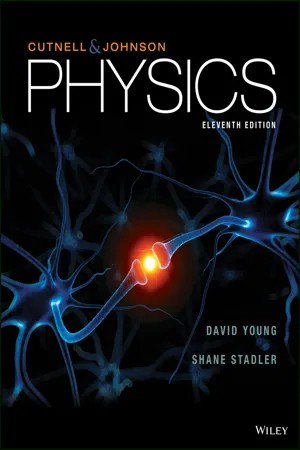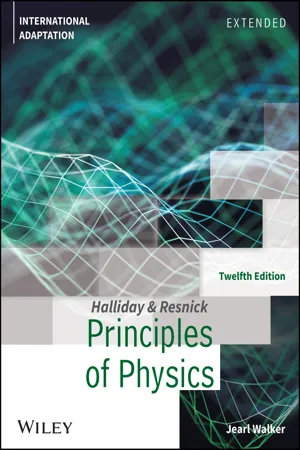Physics
Angular Displacement
Angular displacement refers to the change in the position of a rotating object, measured in degrees or radians. It is the angle through which an object has been rotated in a specific direction. This concept is essential for understanding rotational motion and is used to calculate angular velocity and acceleration.
Written by Perlego with AI-assistance
Related key terms
1 of 5
10 Key excerpts on "Angular Displacement"
- eBook - PDF
- John D. Cutnell, Kenneth W. Johnson, David Young, Shane Stadler(Authors)
- 2015(Publication Date)
- Wiley(Publisher)
8.1 | Rotational Motion and Angular Displacement In the simplest kind of rotation, points on a rigid object move on circular paths. In Figure 8.1, for example, we see the circular paths for points A, B, and C on a spinning skater. The centers of all such circular paths define a line, called the axis of rotation. The angle through which a rigid object rotates about a fixed axis is called the Angular Displacement. Figure 8.2 shows how the Angular Displacement is measured for a rotating compact disc (CD). Here, the axis of rotation passes through the center of the disc and is perpendicular to its surface. On the surface of the CD we draw a radial line, which is a line that intersects the axis of rotation perpendicularly. As the CD turns, we observe the angle through which this line moves relative to a convenient reference line that does not rotate. The radial line moves from its initial orientation at angle u 0 to a final orientation at angle u (Greek letter theta). In the process, the line sweeps out the angle u 2 u 0 . As with other differences that we have encountered (Dx 5 x 2 x 0 , Dv 5 v 2 v 0 , Dt 5 t 2 t 0 ), it is customary to denote the difference between the final and initial angles by the notation Du (read as “delta theta”): Du 5 u 2 u 0 . The angle Du is the Angular Displacement. A rotating object may rotate either counterclockwise or clockwise, and standard convention calls a counterclockwise displacement positive and a clockwise displacement negative. Definition of Angular Displacement When a rigid body rotates about a fixed axis, the Angular Displacement is the angle Du swept out by a line passing through any point on the body and intersecting the axis of rotation perpendicularly. By convention, the Angular Displacement is positive if it is counterclockwise and negative if it is clockwise. SI Unit of Angular Displacement: radian (rad)* Angular Displacement is often expressed in one of three units. - eBook - PDF
- John D. Cutnell, Kenneth W. Johnson, David Young, Shane Stadler(Authors)
- 2021(Publication Date)
- Wiley(Publisher)
218 LEARNING OBJECTIVES After reading this module, you should be able to... 8.1 Define Angular Displacement. 8.2 Define angular velocity and angular acceleration. 8.3 Solve rotational kinematics problems. 8.4 Relate angular and tangential variables. 8.5 Distinguish between centripetal and tan- gential accelerations. 8.6 Analyze rolling motion. 8.7 Use the right-hand rule to determine the direction of angular vectors. 8.1 Rotational Motion and Angular Displacement In the simplest kind of rotation, points on a rigid object move on circular paths. In Figure 8.1, for example, we see the circular paths for points A, B, and C on a spinning skater. The centers of all such circular paths define a line, called the axis of rotation. The angle through which a rigid object rotates about a fixed axis is called the Angular Displacement. Figure 8.2 shows how the angu- lar displacement is measured for a thin rotating disc. Here, the axis of rotation passes through the center of the disc and is perpendicular to its surface. On the surface of the disc we draw a radial line, which is a line that intersects the axis of rotation perpendicularly. As the disc turns, we observe the angle through which this line moves relative to a conve- nient reference line that does not rotate. The radial line moves from its initial orientation at angle θ 0 to a final orientation at angle θ (Greek letter CHAPTER 8 The figure shows the front view of a turbine jet engine on a commercial aircraft. The rotating fan blades collect air into the engine before it is compressed, mixed with fuel, and ignited to produce thrust. The rotational motion of the blades can be described using the concepts of Angular Displacement, angular velocity, and angular acceleration within the framework of rotational kinematics. Mikhail Starodubov/Shutterstock.com Rotational Kinematics 8.1 Rotational Motion and Angular Displacement 219 theta). In the process, the line sweeps out the angle θ − θ 0 . - eBook - PDF
- John D. Cutnell, Kenneth W. Johnson, David Young, Shane Stadler(Authors)
- 2018(Publication Date)
- Wiley(Publisher)
LEARNING OBJECTIVES After reading this module, you should be able to... 8.1 Define Angular Displacement. 8.2 Define angular velocity and angular acceleration. 8.3 Solve rotational kinematics problems. 8.4 Relate angular and tangential variables. 8.5 Distinguish between centripetal and tangential accelerations. 8.6 Analyze rolling motion. 8.7 Use the right-hand rule to determine the direction of angular vectors. Mikhail Starodubov/Shutterstock CHAPTER 8 Rotational Kinematics The figure shows the front view of a turbine jet engine on a commercial aircraft. The rotating fan blades collect air into the engine before it is compressed, mixed with fuel, and ignited to produce thrust. The rotational motion of the blades can be described using the concepts of Angular Displacement, angular velocity, and angular acceleration within the framework of rotational kinematics. 8.1 Rotational Motion and Angular Displacement In the simplest kind of rotation, points on a rigid object move on circular paths. In Figure 8.1, for example, we see the circular paths for points A, B, and C on a spinning skater. The centers of all such circular paths define a line, called the axis of rotation. The angle through which a rigid object rotates about a fixed axis is called the Angular Displacement. Figure 8.2 shows how the Angular Displacement is measured for a rotating compact disc (CD). Here, the axis of rotation passes through the center of the disc and is perpendicular to its surface. On the surface of the CD we draw a radial line, which is a line that intersects the axis of rotation perpendicularly. As the CD turns, we observe the angle through which this line moves relative to a convenient reference line that does not rotate. The radial line moves from its initial orientation at angle 0 to a final orientation at angle (Greek letter theta). In the process, the line sweeps out the angle ‒ 0 . - eBook - PDF
- John D. Cutnell, Kenneth W. Johnson, David Young, Shane Stadler, Heath Jones, Matthew Collins, John Daicopoulos, Boris Blankleider(Authors)
- 2020(Publication Date)
- Wiley(Publisher)
CHAPTER 8 Rotational kinematics LEARNING OBJECTIVES After reading this module, you should be able to: 8.1 define Angular Displacement 8.2 define angular velocity and angular acceleration 8.3 solve rotational kinematics problems 8.4 relate angular and tangential variables 8.5 distinguish between centripetal and tangential accelerations 8.6 analyse rolling motion 8.7 use the right‐hand rule to determine the direction of angular vectors. INTRODUCTION The figure shows the front view of a turbine jet engine on a commercial aircraft. The rotating fan blades collect air into the engine before it is compressed, mixed with fuel, and ignited to produce thrust. The rotational motion of the blades can be described using the concepts of Angular Displacement, angular velocity, and angular acceleration within the framework of rotational kinematics. Source: Mikhail Starodubov / Shutterstock 8.1 Rotational motion and Angular Displacement LEARNING OBJECTIVE 8.1 Define Angular Displacement. FIGURE 8.1 When a rigid object rotates, points on the object, such as A, B, or C, move on circular paths. The centres of the circles form a line that is the axis of rotation. A B C Axis of rotation In the simplest kind of rotation, points on a rigid object move on circular paths. In figure 8.1, for example, we see the circular paths for points A, B, and C on a spinning skater. The centres of all such circular paths define a line, called the axis of rotation. The angle through which a rigid object rotates about a fixed axis is called the Angular Displacement. Figure 8.2 shows how the Angular Displacement is measured for a rotating compact disc (CD). Here, the axis of rotation passes through the centre of the disc and is perpendicular to its surface. On the surface of the CD we draw a radial line, which is a line that intersects the axis of rotation perpendicularly. As the CD turns, we observe the angle through which this line moves relative to a convenient reference line that does not rotate. - eBook - ePub
- John D. Cutnell, Kenneth W. Johnson, David Young, Shane Stadler(Authors)
- 2018(Publication Date)
- Wiley(Publisher)
On the surface of the CD we draw a radial line, which is a line that intersects the axis of rotation perpendicularly. As the CD turns, we observe the angle through which this line moves relative to a convenient reference line that does not rotate. The radial line moves from its initial orientation at angle θ 0 to a final orientation at angle θ (Greek letter theta). In the process, the line sweeps out the angle θ − θ 0. As with other differences that we have encountered (Δ x = x − x 0, Δ v = v − v 0, Δ t = t − t 0), it is customary to denote the difference between the final and initial angles by the notation Δ θ (read as “delta theta”): Δ θ = θ − θ 0. The angle Δ θ is the Angular Displacement. A rotating object may rotate either counterclockwise or clockwise, and standard convention calls a counterclockwise displacement positive and a clockwise displacement negative. Figure 8.2 The Angular Displacement of a CD is the angle Δ θ swept out by a radial line as the disc turns about its axis of rotation. DEFINITION OF Angular Displacement When a rigid body rotates about a fixed axis, the Angular Displacement is the angle Δ θ swept out by a line passing through any point on the body and intersecting the axis of rotation perpendicularly. By convention, the Angular Displacement is positive if it is counterclockwise and negative if it is clockwise. SI Unit of Angular Displacement: radian (rad) * Angular Displacement is often expressed in one of three units. The first is the familiar degree, and it is well known that there are 360 degrees in a circle. The second unit is the revolution (rev), one revolution representing one complete turn of 360°. The most useful unit from a scientific viewpoint, however, is the SI unit called the radian (rad). Figure 8.3 shows how the radian is defined, again using a CD as an example. The picture focuses attention on a point P on the disc - eBook - PDF
- Michael Tammaro(Author)
- 2019(Publication Date)
- Wiley(Publisher)
The radius of the circular path of a particular point is equal to the shortest straight-line dis- tance from that point to the axis of rotation (or simply the axis). This is demonstrated in Animated Figure 8.1.1(a), which shows the rotating blades of a wind turbine. Activate ani- mation (a) to see two different points on the blades trace out circular paths about the axis or rotation. The axis of rotation is defined as the unique line that passes through the common center of all such circles and is perpendicular to the plane of these circles. 8.1 ANGULAR POSITION AND DISPLACEMENT Learning Objectives Animated Figure 8.1.1 (a) When a rigid body rotates about a fixed axis, points on that body make circular paths about that axis of rotation. (b) The Angular Displacement is defined as the change in angular position. I N T E R A C T I V E F E A T U R E Animated Figure 8.1.1(b) shows a head-on view of the wind turbine (the axis of rotation is perpendicular to the screen, so it appears simply as a dot). To specify the orientation of the blades, we designate a reference line that is perpendicular to the axis. In animation (b), the initial angular position of the blade is 0 θ . When the blade turns, it comes to rest at a new angular position θ , which we call its final angular position. (The words “initial” and “final” may suggest that the blades are at rest at these positions. Though they are in this case, this is not always true.) The Angular Displacement Δ θ is the difference between the final and initial angular positions: Angular Displacement When a rigid body rotates from an initial angular position 0 θ to a final angular position θ , its Angular Displacement Δ θ is the change in angular position: 0 θ θ θ Δ = - (8.1.1) I N T E R A C T I V E F E A T U R E 206 | Chapter 8 The SI unit of angular rotation is the radian (rad), but degrees (deg) and revolutions (rev) are commonly used, too. - David Halliday, Robert Resnick, Jearl Walker(Authors)
- 2023(Publication Date)
- Wiley(Publisher)
It is not easy to get used to representing angular quantities as vectors. We instinctively expect that something should be moving along the direction of a vector. That is not the case here. Instead, something (the rigid body) is rotating around the direction of the vector. In the world of pure rotation, a vector defines an axis of rotation, not a direction in which something moves. None- theless, the vector also defines the motion. Furthermore, it obeys all the rules for vector manipulation discussed in Chapter 3. The angular acceleration a → is another vector, and it too obeys those rules. In this chapter we consider only rotations that are about a fixed axis. For such situations, we need not consider vectors—we can repre- sent angular velocity with ω and angular acceleration with α, and we can indicate direction with an implied plus sign for counterclockwise or an explicit minus sign for clockwise. Angular Displacements. Now for the caution: Angular displace- ments (unless they are very small) cannot be treated as vectors. Why not? We can certainly give them both magnitude and direction, as we did for the angular velocity vector in Fig. 10.1.6. However, to be represented as a vector, a quantity must also obey the rules of vec- tor addition, one of which says that if you add two vectors, the order in which you add them does not matter. Angular Displacements fail this test. Figure 10.1.7 gives an example. An initially horizontal book is given two 90° Angular Displacements, first in the order of Fig. 10.1.7a and then in the order of Fig. 10.1.7b. Although the two angular dis- placements are identical, their order is not, and the book ends up with different orientations. Here’s another example. Hold your right arm downward, palm toward your thigh. Keeping your wrist rigid, (1) lift the arm forward until it is horizontal, (2) move it horizontally until it points toward the right, and (3) then bring it down to your side.- eBook - PDF
- David Halliday, Robert Resnick, Jearl Walker(Authors)
- 2021(Publication Date)
- Wiley(Publisher)
It is not easy to get used to representing angular quantities as vec- tors. We instinctively expect that something should be moving along the direction of a vector. That is not the case here. Instead, some- thing (the rigid body) is rotating around the direction of the vector. In the world of pure rotation, a vector defines an axis of rotation, not a direction in which something moves. Nonetheless, the vector also defines the motion. Furthermore, it obeys all the rules for vector manipulation discussed in Chapter 3. The angular acceleration a → is another vector, and it too obeys those rules. In this chapter we consider only rotations that are about a fixed axis. For such situations, we need not consider vectors—we can rep- resent angular velocity with ω and angular acceleration with α, and we can indicate direction with an implied plus sign for counterclockwise or an explicit minus sign for clockwise. Angular Displacements. Now for the caution: Angular displace- ments (unless they are very small) cannot be treated as vectors. Why not? We can certainly give them both magnitude and direction, as we did for the angular velocity vector in Fig. 10.1.6. However, to be represented as a vector, a quantity must also obey the rules of vec- tor addition, one of which says that if you add two vectors, the order in which you add them does not matter. Angular Displacements fail this test. Figure 10.1.7 gives an example. An initially horizontal book is given two 90° Angular Displacements, first in the order of Fig. 10.1.7a and then in the order of Fig. 10.1.7b. Although the two angular dis- placements are identical, their order is not, and the book ends up with different orientations. Here’s another example. Hold your right arm downward, palm toward your thigh. Keeping your wrist Figure 10.1.6 (a) A record rotating about a vertical axis that coincides with the axis of the spindle. - No longer available |Learn more
Physics for Scientists and Engineers
Foundations and Connections, Extended Version with Modern Physics
- Debora Katz(Author)
- 2016(Publication Date)
- Cengage Learning EMEA(Publisher)
The reference line rotates with the object. For the potato in Figure 12.6B, we have picked a reference line that passes through the rotation axis and a spot (“an eye”) on the potato labeled P. Angular Position and Angular Displacement Polar coordinates are used to describe rotational motion (Chapter 4). The angular position u of the reference line is measured counterclockwise from the positive x axis as shown in Figure 12.6B. The angular position u is negative if it is measured clock- wise from the positive x axis. In rotational kinematics, we specify the angular position in radians because it is simpler to work with radians than degrees or revolutions. Consider the angle u shown in Figure 12.7. The circle has radius r, and s is the arc length subtended by u; so, in radians, u is u 5 s r (12.1) From Equation 12.1, an angle in radians is the ratio of two lengths and is therefore dimensionless. For example, if s 5 5.0 m and r 5 2.5 m, then u 5 s / r 5 5.0 m / 2.5 m 5 2.0 according to Equation 12.1. We write u 5 2.0 “rad” to clarify that the angle is measured in radians and not in degrees or revolutions. Equation 12.1 does not hold if u is measured in degrees or revolutions; in rotational kinematics, we convert all angles to radians. Because a radian comes from a dimensionless ratio, we often drop the “rad” when radian measure is understood from the context. The angular position u 1t 2 is a function of time for a rotating object. If, for exam- ple, at t 5 0 the reference line were aligned with the positive x axis, then u 10 2 5 0. When the potato completes one revolution so that the reference line is once again lined up with the positive x axis, the angular position is not zero, but 2p rad. A change in the angular position is known as the Angular Displacement, Du 5 u f 2 u i (12.2) where (as usual) i and f stand for initial and final, respectively. Figure 12.8 shows the Angular Displacement of the potato. - eBook - PDF
- David Halliday, Robert Resnick, Jearl Walker(Authors)
- 2020(Publication Date)
- Wiley(Publisher)
For such situations, we need not consider vectors — we can represent angular velocity with ω and angular acceleration with α, and we can indicate direction with an implied plus sign for counterclockwise or an explicit minus sign for clockwise. Angular Displacements. Now for the caution: Angular Displacements (unless they are very small) cannot be treated as vectors. Why not? We can cer- tainly give them both magnitude and direction, as we did for the angular veloc- ity vector in Fig. 10-6. However, to be represented as a vector, a quantity must also obey the rules of vector addition, one of which says that if you add two vectors, the order in which you add them does not matter. Angular displace- ments fail this test. Figure 10-7 gives an example. An initially horizontal book is given two 90° Angular Displacements, first in the order of Fig. 10-7a and then in the order of Fig. 10-7b. Although the two Angular Displacements are identical, their order is not, and the book ends up with different orientations. Here’s another example. Hold your right arm downward, palm toward your thigh. Keeping your wrist rigid, (1) lift the arm forward until it is horizontal, (2) move it hori- zontally until it points toward the right, and (3) then bring it down to your side. Your palm faces forward. If you start over, but reverse the steps, which way does your palm end up facing? From either example, we must conclude that the addition of two Angular Displacements depends on their order and they cannot be vectors. Figure 10-6 (a) A record rotating about a vertical axis that coincides with the axis of the spindle. (b) The angular velocity of the rotating record can be represented by the vector ω → , lying along the axis and pointing down, as shown. (c) We establish the direction of the angular velocity vector as downward by using a right-hand rule. When the fingers of the right hand curl around the record and point the way it is moving, the extended thumb points in the direction of ω → .
Index pages curate the most relevant extracts from our library of academic textbooks. They’ve been created using an in-house natural language model (NLM), each adding context and meaning to key research topics.









